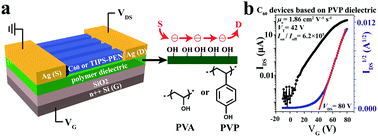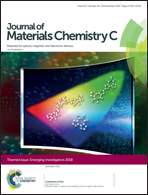Electron transport at the interface of organic semiconductors and hydroxyl-containing dielectrics†
Abstract
Dielectric material design is challenging for the fabrication of n-channel organic field-effect transistors (OFETs). Hydroxyl groups in dielectrics have been found to intensively trap electrons and completely eliminate electron transport in a variety of structurally disordered organic semiconductors, which generally excludes the widely used hydroxyl-containing dielectrics from n-channel OFETs. Here, we show that electrons are clearly more mobile at the interface of organic semiconductors and hydroxyl-containing dielectrics, including silica, polyvinyl alcohol (PVA) and poly(4-vinyl phenol) (PVP), when single-crystalline C60 or 6,13-bis(triisopropylsilylethynyl)pentacene (TIPS-pentacene) are used as semiconductors in OFETs. With regards to C60, an electron mobility larger than 1 cm2 V−1 s−1 has been achieved, indicating that the hydroxyl groups have a limited trapping effect on electron transport. Electron trapping becomes more intensive either by exposing the dielectric/device to air or by increasing the hydroxyl density in the dielectrics, suggesting that the trapping effect is associated with water absorbed by the dielectrics. By showing their limited negative effect, this work suggests that the widely used, easily accessible and well-known hydroxyl groups might be incorporated into organic electronic materials for n-channel OFETs and complementary circuits fabricated in a glove box.

- This article is part of the themed collection: Journal of Materials Chemistry C Emerging Investigators


 Please wait while we load your content...
Please wait while we load your content...